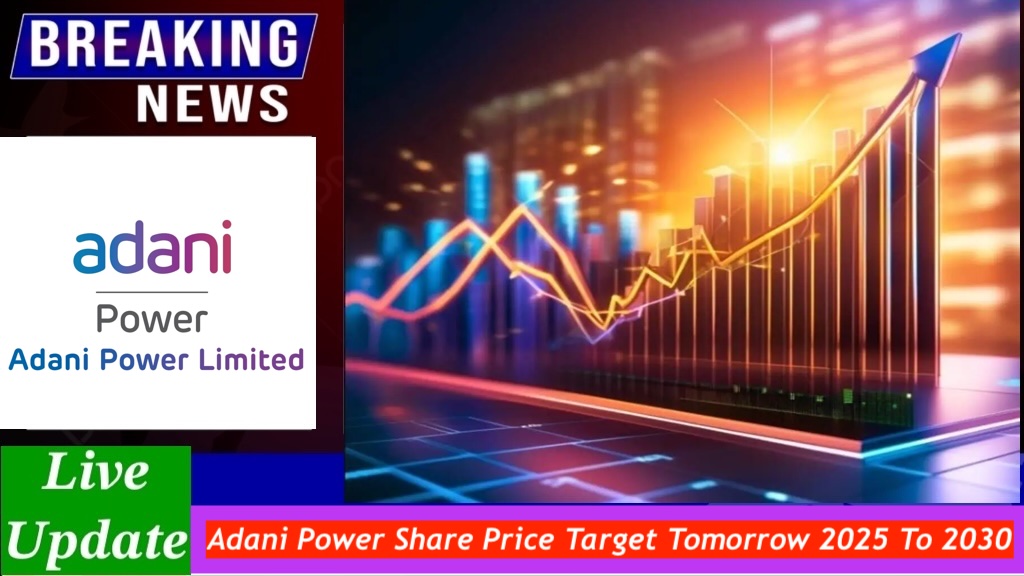Adani Power Share Price Target Adani Power Ltd is one of India’s leading power companies, specializing in the generation of electricity to meet the country’s growing energy demands. The company operates a series of thermal power plants and is expanding its renewable energy capabilities to promote sustainable development. Adani Power plays a crucial role in delivering reliable and affordable electricity across India. As of 10 January 2025, Adani Power’s share price on the NSE is ₹482.75 INR.
Adani Power Share Price Target Tomorrow 2025 To 2030
Adani Power Share Price Target Tomorrow 2025 ₹900, 2026 ₹1200, 2027 ₹1500, 2028 ₹1700, 2029 ₹1900 To 2030 ₹2100. Adani Power is an Indian multinational power and energy company, subsidiary of Adani Group and based in Khodiyar in Ahmedabad, India. It is a private thermal power producer, with a capacity of 15,250 MW and operates a mega solar plant of 40 MW at Naliya, Bitta, Kutch, Gujarat.
CEO: Shersingh B Khyalia (11 Jan 2022–)
Founded: 22 August 1996
Founder: Gautam Adani
Headquarters: Ahmedabad
Number of employees: 3,295 (2024)
Parent organization: Adani Group
Subsidiaries: Mundra Petrochem Limited ·
Adani Power Market Overview
| Metric | Value |
| Open Price | ₹498.00 |
| High Price | ₹502.90 |
| Low Price | ₹478.45 |
| Previous Close | ₹497.90 |
| Volume | 3,638,339 |
| Value (Lacs) | ₹17,547.71 |
| VWAP | ₹486.02 |
| P/E Ratio | 15.43 |
| Upper Circuit Limit | ₹597.45 |
| Lower Circuit Limit | ₹398.35 |
| 52-Week High | ₹895.85 |
| 52-Week Low | ₹432.00 |
| Market Cap | ₹186,020 Cr |
| Face Value | ₹10 |
Adani Power Share Price Target (2025 – 2030)
| Year | Share Price Target (INR) |
| 2025 | ₹900 |
| 2026 | ₹1200 |
| 2027 | ₹1500 |
| 2028 | ₹1700 |
| 2029 | ₹1900 |
| 2030 | ₹2100 |
| Category | Stock Market |
Key Risks and Challenges for Adani Power Share Price Target for 2025
The expected share price target for Adani Power in 2025 is ₹900. However, the following risks could impact the share price:
- Dependence on Coal and Fuel Price Volatility: Adani Power’s reliance on coal for thermal power generation exposes the company to fluctuations in coal prices and potential supply shortages. Any increase in fuel costs or disruptions in imports could raise operating expenses and squeeze profit margins.
- Regulatory and Environmental Policies: Stricter environmental regulations or changes in government policies related to carbon emissions and thermal power plants could increase compliance costs. These changes may also require substantial investments in cleaner technologies, impacting profitability.
- Competition in the Energy Sector: As the focus on renewable energy increases, Adani Power faces rising competition. If the company is unable to expand its renewable energy portfolio or adapt to the evolving energy landscape, it could lose market share to more nimble or sustainable competitors.
- Economic and Global Market Uncertainty: Economic slowdowns or geopolitical tensions can affect industrial and commercial electricity demand, slowing revenue growth. Additionally, volatility in global energy markets may influence investor sentiment, negatively impacting the company’s stock price.
Key Risks and Challenges for Adani Power Share Price Target for 2030
The expected share price target for Adani Power in 2030 is ₹2100. Key risks include:
- Transition to Renewable Energy: The global transition to renewable energy presents a challenge for Adani Power, which still relies heavily on thermal power generation. Delayed adoption of clean energy sources may result in declining demand and increasing regulatory pressures, negatively affecting long-term growth.
- Regulatory and Environmental Constraints: Stricter environmental laws and carbon emission targets could raise operational costs for coal-based plants. If Adani Power fails to meet these standards, it may face penalties, restrictions, or other financial setbacks, impacting its profitability and stock performance.
- Technological Disruptions: Rapid advancements in energy storage, solar, and wind technologies could make traditional thermal power generation less competitive. Adani Power may need to invest significantly in these technologies to stay relevant, which could strain financial resources.
- Economic and Market Volatility: Domestic and global economic fluctuations can impact electricity demand, especially from industrial and commercial sectors. Factors like economic downturns, inflation, or rising interest rates could also deter investments in the energy sector, negatively influencing the company’s share price.
Adani Power Shareholding Pattern
| Shareholder Type | Percentage |
| Promoters | 74.96% |
| Foreign Institutional Investors (FII) | 12.66% |
| Domestic Institutional Investors (DII) | 1.53% |
| Public | 10.85% |
Adani Power Financial Overview
| Metric | Value | Y/Y Change |
| Revenue | ₹503.51B | +29.86% |
| Operating Expense | ₹61.26B | +21.57% |
| Net Income | ₹208.29B | +94.18% |
| Net Profit Margin | 41.37% | +49.57% |
| Earnings per Share | — | — |
| EBITDA | ₹182.16B | +78.54% |
| Effective Tax Rate | -0.18% | — |
Who is CEO of Adani Power?
Is ADANIPOWER a good buy?
Adani Power is trading below its 20, 50, 100, and 200-day EMAs, which reflects significant weakness in its technical structure. This consistent underperformance suggests that the stock is unable to gather any upward momentum in the current market environment.
Who is the highest paid employee in Adani?
The highest-paying job at Adani Group is a Senior Vice President with a salary of ₹1 Crore to ₹1.6 Crore per year. The top 10% of employees earn more than ₹28.85 lakhs per year. The top 1% earn more than a whopping ₹80.83 lakhs per year.
